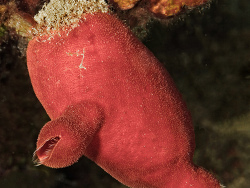Info
(Linnaeus, 1767)
Synonyms:
Ascidea rustica Risso, 1826
Ascidia rustica Risso, 1826
Cynthia papillata Savigny, 1816
Cynthia papillosa (Gunnerus, 1765)
Pyura papillosa (Gunnerus, 1765)
Tethyum coriaceum Bohadsch, 1761
Tethyum papillosum Gunnerus, 1765
Classification: Biota > Animalia (Kingdom) > Chordata (Phylum) > Tunicata (Subphylum) > Ascidiacea (Class) > Stolidobranchia (Order) > Pyuridae (Family) > Halocynthia (Genus) > Halocynthia papillosa (Species)
Synonyms:
Ascidea rustica Risso, 1826
Ascidia rustica Risso, 1826
Cynthia papillata Savigny, 1816
Cynthia papillosa (Gunnerus, 1765)
Pyura papillosa (Gunnerus, 1765)
Tethyum coriaceum Bohadsch, 1761
Tethyum papillosum Gunnerus, 1765
Classification: Biota > Animalia (Kingdom) > Chordata (Phylum) > Tunicata (Subphylum) > Ascidiacea (Class) > Stolidobranchia (Order) > Pyuridae (Family) > Halocynthia (Genus) > Halocynthia papillosa (Species)







 Silke Baron (flickr prilfish), Austria
Silke Baron (flickr prilfish), Austria













